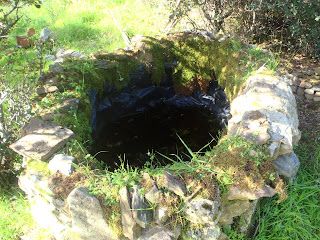Nas introduções de árvores de
fruto, estamos a optar por uma situação de agro-floresta de produção de alimentos,
conciliando as frutíferas com a floresta natural existente e também as espécies de frutos selvagens existentes como, Pereiras bravas, Medronheiros, Amoras, bagas de Crataegus e azeitonas bravas.
Assim, temos por aqui uma vegetação predominante de Azinheiras (Quercus rotundifolia) de várias idades, com alguma densidade, consociadas com pilriteiros (Crataegus monogyma) e regeneração natural de oliveira brava (Olea europea silvestris).
Optou-se de momento por duas situações de localização para as arvores de fruto introduzidas:
Até ao momento foram plantadas as seguintes árvores de fruto:
Laranjeiras
Tangerineiras
romãzeiras
Figueiras
Oliveiras
Alfarrobeiras
Pessegueiros (variedades Catarino e amarelo)
Macieiras (Variedades bravo esmolfe, Reineta e Malápio)
Ameixeiras
Diospireiros
Medronheiros
Amendoeiras
Aveleiras
Mirtilos
Framboesas
Pinheiros mansos
Videiras
Castanheiros
Cerejeiras
Aveleiras
Kiwis
Orchards
In the introductions of fruit trees, we chose the option for a situation of agro-forest food production, combining the domestic fruit with the existing natural forest, and also existing wild fruits, such as Wild pear, Strawberry tree, Blackberries (brambles), Hawthorns, wild olives.
So we have here a predominant tree vegetation of Holm oaks (Quercus rotundifolia) with various ages, some density, consociated with hawthorns (Crataegus monogyma) and natural regeneration of wild olives (Olea europea silvestris).
We decided this two situations, about location for the fruit trees introduced:
These hedges branches will help in the protection and growth of the new plants, they provide shade, secure and hold the water,compost and protect from the circulation of people or machines.
So far have been planted this fruit trees:
Orange
Mandarines
Pomegranates
Fig
Olives
Carob
Peach (varieties Catarino and yellow)
Apple (varieties Bravo Esmolfe, reineta and Malápio)
Plum
Caqui
Starwberry trees
Almond
Hazels
Blueberries
Raspberries
Pines
Vines
Wall nut
Chestnut
Cherry
Kiwis
And many wild pear trees have been planted.
This year, they will create roots and geet strong, and next spring 2014, wil be grafted with varietys of domestic pears.
The roots will be strong and the fruit sweet
Optou-se de momento por duas situações de localização para as arvores de fruto introduzidas:
- Plantação em clareiras no caso de espécies mais resistentes ao sol e frio, intensos nesta região, e plantação na protecção das copas de azinheiras para o lado sul para espécies mais sensíveis, particularmente ao frio e geadas como o caso de arvores de citrinos.
- Plantação ao abrigo da protecção das faixas de ramos que foram dispostas no terreno, resultantes das podas.
Até ao momento foram plantadas as seguintes árvores de fruto:
Laranjeiras
Tangerineiras
romãzeiras
Figueiras
Oliveiras
Alfarrobeiras
Pessegueiros (variedades Catarino e amarelo)
Macieiras (Variedades bravo esmolfe, Reineta e Malápio)
Ameixeiras
Diospireiros
Medronheiros
Amendoeiras
Aveleiras
Mirtilos
Framboesas
Pinheiros mansos
Videiras
Castanheiros
Cerejeiras
Aveleiras
Kiwis
Orchards
In the introductions of fruit trees, we chose the option for a situation of agro-forest food production, combining the domestic fruit with the existing natural forest, and also existing wild fruits, such as Wild pear, Strawberry tree, Blackberries (brambles), Hawthorns, wild olives.
So we have here a predominant tree vegetation of Holm oaks (Quercus rotundifolia) with various ages, some density, consociated with hawthorns (Crataegus monogyma) and natural regeneration of wild olives (Olea europea silvestris).
We decided this two situations, about location for the fruit trees introduced:
- Planting in gaps, for the fruit species more resistant to heat and cold, that is intense in this region. Planting "half-above" the protecting of the Holm oaks canopy, to the south side, is the location used for the most sensitive species, particularly to cold and frost, such as citrus trees.
- Planting under the protective branches of tracks that were laid on the ground, resulting from pruning the low branches of the Holm oaks.
These hedges branches will help in the protection and growth of the new plants, they provide shade, secure and hold the water,compost and protect from the circulation of people or machines.
So far have been planted this fruit trees:
Orange
Mandarines
Pomegranates
Fig
Olives
Carob
Peach (varieties Catarino and yellow)
Apple (varieties Bravo Esmolfe, reineta and Malápio)
Plum
Caqui
Starwberry trees
Almond
Hazels
Blueberries
Raspberries
Pines
Vines
Wall nut
Chestnut
Cherry
Kiwis
And many wild pear trees have been planted.
This year, they will create roots and geet strong, and next spring 2014, wil be grafted with varietys of domestic pears.
The roots will be strong and the fruit sweet



























